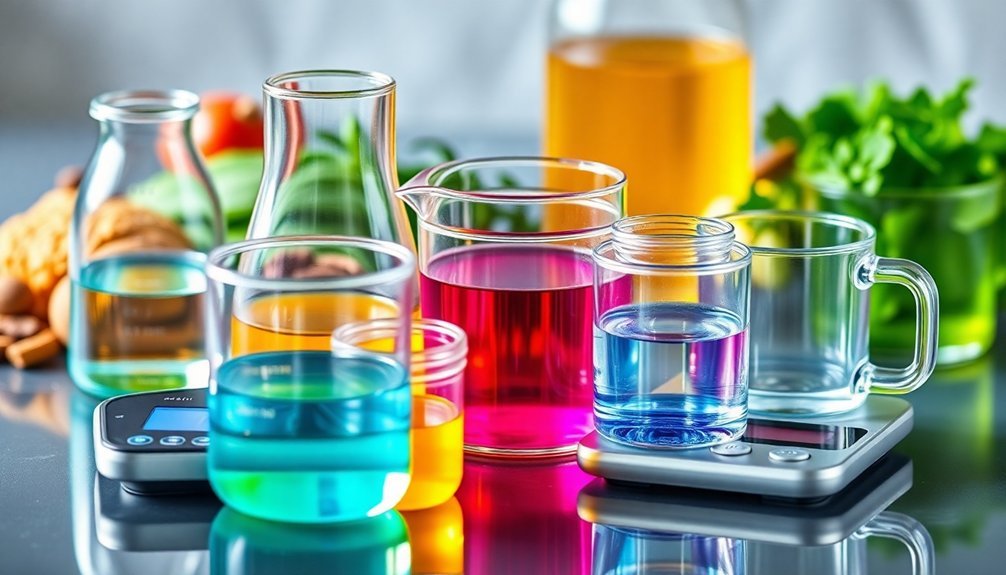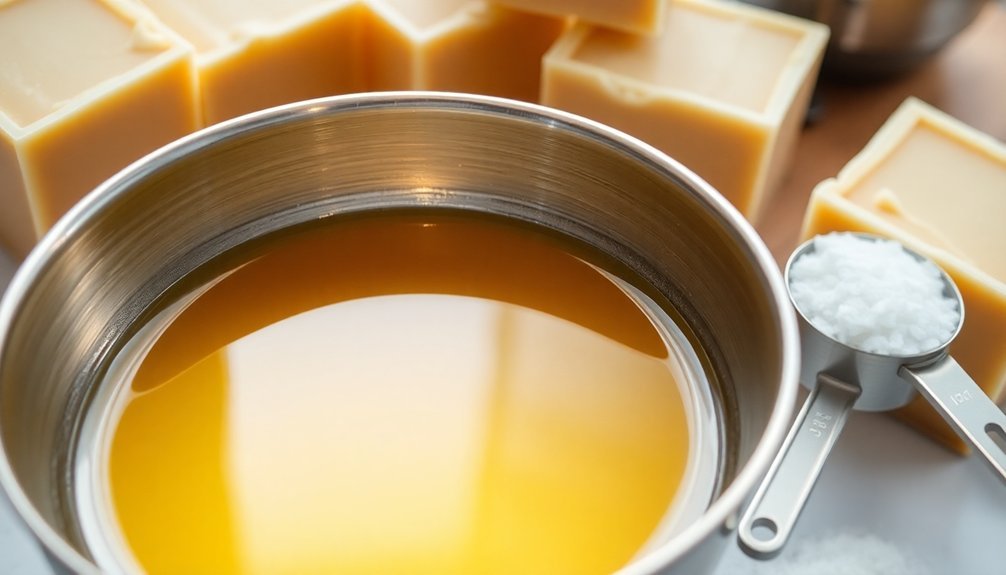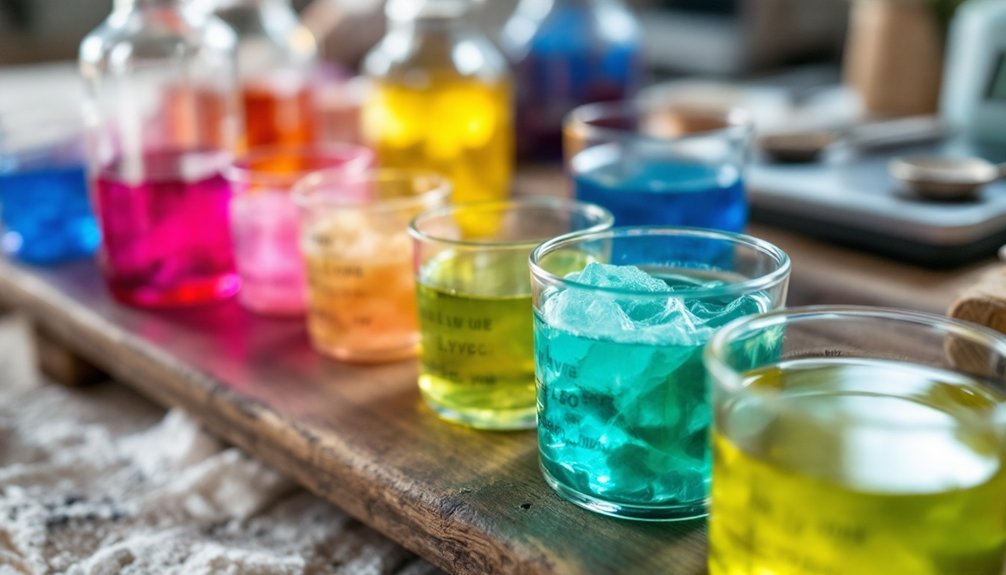For soap making success, you'll want to master these five water-to-lye ratios: the beginner-friendly 2:1 ratio (33% lye concentration), the 1.8:1 ratio for slightly faster trace, the 1.5:1 ratio (40% concentration) for harder bars, the advanced 1:1 ratio (50% concentration) for expert control, and the balanced 38% solution method (approximately 1.6:1 ratio). Each ratio affects working time, curing period, and final soap texture. These formulations will transform your soap making journey from basic to professional-grade.
5 Best Ratios For Converting Lye Bath Recipes

When converting traditional lye bath recipes to your own formulations, understanding the fundamental water-to-lye ratios is crucial for successful soap making. Most standard recipes use a 38% water percentage based on oil weight, not lye weight. For beginners, a 2:1 water-to-lye ratio provides safety and working time.
Proper water-to-lye ratios form the backbone of successful soap formulation, especially when converting traditional recipes to personal creations.
As you gain experience, you'll likely prefer lower ratios like 1.8:1 or 1.5:1, which promote faster trace and shorter curing periods. High olive oil recipes benefit from these reduced water amounts to prevent overly soft soap. For homemade alternatives, you can create a substitute by baking baking soda at 120°C/250°F for an hour to intensify its alkaline properties.
Remember that different oils have unique saponification values, requiring precise lye calculations. You'll need to adjust your water ratio based on additives, fragrances, and design techniques.
Using a reliable lye calculator helps guarantee your converted recipes maintain proper chemistry while achieving your desired soap qualities.
The Standard 2:1 Water-to-Lye Ratio for Beginners
The 2:1 water-to-lye ratio stands as the gold standard for novice soap makers seeking reliability and safety. This proportion creates a 33% lye concentration that's manageable while effectively dissolving the sodium hydroxide.
You'll find this ratio particularly beneficial as you learn the craft—it provides sufficient working time for basic designs and swirls without rushing your process. The resulting soap achieves a balanced texture that's neither too soft nor too hard.
When you're just starting out, this ratio offers welcomed simplicity in your calculations while reducing potential safety risks. This standard dilution provides enough water to properly dissolve the lye for successful saponification. Your soaps will cure within a reasonable timeframe and maintain consistent quality.
As you gain experience, you can adjust this ratio to accommodate specific recipes, but for now, this balanced approach gives you both safety and flexibility.
Achieving Hard Bars With a 1.5:1 Reduced Water Ratio

Serious soap crafters looking for harder bars often turn to the 1.5:1 water-to-lye ratio as their next evolution in technique.
This balanced ratio creates approximately 40% lye solution strength, accelerating trace and promoting faster curing without compromising lye solubility.
You'll notice several benefits: reduced curing time, minimized soda ash formation, and prevention of glycerin rivers.
These advantages make this ratio ideal for intricate designs that require firm, well-defined patterns.
Perfect for detailed soap designs where crisp lines and sharp definitions matter most.
Remember to adjust your process for the faster trace—be prepared to work more quickly.
When formulating recipes, select hardening oils like coconut or palm to enhance bar firmness, and carefully manage your superfat percentage to maintain moisturizing properties. A small superfat of 5-7% provides essential skin conditioning benefits while maintaining the cleansing properties of your hard bar soap.
Proper ventilation during curing remains essential, as does accounting for any liquid additives in your water calculations.
Mastering the 1:1 Concentrated Ratio for Advanced Soapers
Veteran soapmakers seeking the ultimate control over their formulations often gravitate toward the concentrated 1:1 water-to-lye ratio, which creates a potent 50% lye solution. This approach offers significant advantages for master batching while requiring heightened safety awareness. The 1:1 ratio can be particularly challenging when using fragrance oils that tend to accelerate trace, as experienced by many soapers.
| Aspect | 1:1 Ratio Benefits | Safety Considerations |
|---|---|---|
| Concentration | 50% solution for precise control | Generates extreme heat during mixing |
| Master Batching | Efficient space usage for storage | Requires chemical-resistant containers |
| Cure Time | Produces harder bars initially | Need proper ventilation during use |
| Workflow | Allows adding water later as needed | Always wear protective equipment |
| Reaction Speed | Accelerates saponification process | Never add water to concentrated solution |
When working with this concentration, you'll need to be extremely cautious. The exothermic reaction can reach dangerous temperatures, but the control you'll gain over your soap properties makes it worthwhile for experienced crafters.
The 38% Lye Solution Method for Balanced Cure Times

Finding the perfect balance between workability and cure time, a 38% lye solution offers soapmakers the ideal middle ground in their craft. This concentration creates bars that harden efficiently while still providing adequate working time before trace occurs.
To achieve this ratio, you'll calculate your lye amount based on your oils, then use water at 1.6 times the weight of your lye. This creates a solution where lye makes up 38% of the water-lye mixture.
You'll notice your soap sets up faster than full-water recipes but remains manageable during pouring. This approach helps prevent uneven saponification that can occur with higher lye concentrations.
The 38% method works exceptionally well with varied oil blends and superfat percentages. It reduces curing time considerably without the challenges that come with more concentrated solutions, making it perfect for soapmakers ready to advance beyond beginner formulations.
Frequently Asked Questions
How Do I Convert Liquid Soap Ratios to Solid Bar Recipes?
You'll need to adjust lye type from KOH to NaOH and recalculate using proper saponification values. Use a soap calculator, reduce water amount, and modify oil ratios to achieve harder bars with desired properties.
Can I Adjust Lye Ratios When Using Specialty Oils?
Yes, you must adjust lye ratios when using specialty oils. Each oil has a unique SAP value requiring specific lye amounts. Use a soap calculator to determine correct ratios and consider adding a 5-8% superfat for safety.
What Ratio Works Best for Hot Process Soap Making?
For hot process soap making, you'll get best results using a 2:1 to 3:1 water-to-lye ratio. This provides enough moisture for cooking while maintaining workability. You can adjust based on your desired soap texture.
How Do Seasonal Temperature Changes Affect Ideal Water-To-Lye Ratios?
In warmer seasons, you'll want higher water-to-lye ratios (around 2.5:1) to slow saponification. In colder conditions, you can use lower ratios (around 1.8:1) as reactions naturally slow down with temperature.
Are Lye Ratios Different for Milk-Based or Beer Soap Recipes?
Yes, you'll need different lye ratios for milk and beer soaps. Milk needs frozen preparation to prevent scorching, while beer's sugars require special handling. Both ingredients affect saponification and require lye calculator adjustments.
In Summary
Whether you're a beginner starting with the safe 2:1 water-to-lye ratio or an expert using the concentrated 1:1 formula, you'll find that understanding these five ratios transforms your soapmaking results. Experiment gradually with reduced water amounts as you gain confidence. Your bars will cure faster and harder with less water, but don't rush the process. Master one ratio before moving to the next for consistent, professional-quality soap every time.





Leave a Reply